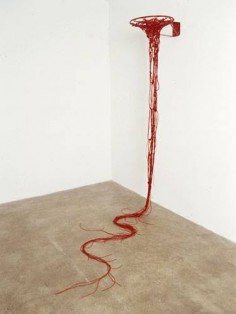DARIO ESCOBAR
Дарио Эскобар
达里奥·埃斯科瓦尔
source: mymodernmet
Guatemala-based artist Dario Escobar redesigns the structure of sporting goods. A trained architect, Escobar reconstructs athletic gear, slicing the equipment and assembling them in an atypical fashion. Initially, the pieces seemed to shine a light on the importance of design and our innate recognition of consumer goods. Despite disfigurement, we can identify what item Escobar has reworked.
Delving in deeper, I realize that many of these sculptural installations rendered the original products useless. The artist’s interesting and unusual design practices redefine the purpose and often challenge the functionality of these items. Growing up in Guatemala, Escobar was surrounded by a clear class divide where the wealthy were members of fitness centers and recreational clubs. These series of works seem to reflect his response to elite activities driven by consumerism.
.
.
.
.
.
.
.
source: bangstyle
At first glance, Dario Escobar’s reconstructed sporting goods confuse and delight the eye. Soccer balls hang suspended in air; cracked and painted baseball bats adorn walls in undulating formations; holes perforate skateboards; roller blades sprout razor-edged spikes. The re-purposed items, though unique in form, are not unique to the function of the art the Guatemalan artist specializes in creating. The trained architect has made his name by re-evaluating the average good, from McDonald’s cups and Cornflakes boxes to paper birthday party hats. He has earned his reputation as a societal critic by manipulating each consumerist object, transforming the harmlessly ordinary item into a thought-provoking critique on contemporary culture.
This collection of re-conceptualized sporting goods is no different.
“Growing up in Guatemala, Escobar was surrounded by a clear class divide where the wealthy were members of fitness centers and recreational clubs. These series of works seem to reflect his response to elite activities driven by consumerism,” Modern Met writes, noting that the deconstruction of the equipment has left the items “useless” to perform their intended function.
Writer Kevin Power notes that Guatemala, as of 2006, was still one of the most violent places on Earth, a fact often covered up by cushy middle and upper classes which comprise only a quarter of the population. He notes that Escobar’s choice of everyday consumer objects references the role consumerism played in both exacerbating these class differences and contributing to the “blindness” of the more wealthy tiers to the poverty taking place around them.
“In short, [Escobar’s] works have a socio-ideological edge, rhetorically figured through irony and parody, but none of this should obscure the central fact that they constitute an ongoing dialogue with the history and function of the art object. He provides us with an icy, polished yet vulnerable, smile, that transfers itself to his work as a glistening surface veneer that serves as location for a cutting critique,” Powers states in his article, “Dario Escobar: Local and glocal simulacra.”
Thus, Escobar’s skateboard-turned-mini Mercedes is less whimsical than it is ironic. His razor-blade-studded rollerblades carry a sinister connotation. His severed baseball bats represent “an investigation into the idea of equilibrium and presentation,” the artist notes on his website. The single soccer ball, taken apart and sewn back together inside out, symbolizes “a meditation on what is inside and what is outside.”
“Nothing is ever quite what it is,” Powers purports of the artist’s work. “Dario takes a playfully morbid delight in the images of the culture industry and upsets the apple cart! He may be fascinated, but he is not a believer and stands at a critical distance using irony as a dismantling rhetoric.”
On second glance, Escobar’s reconstructed sporting goods are no longer confusing or delightful. They’re much more complex than that.
.
.
.
.
.
.
.
source: picpostmthai
เจ๋งเว่อร์ อุปกรณ์กีฬา ถูกนำมาสร้างงานศิลปะ รูปงานศิลป์ งานศิลปะ ที่คุณเห็นอยู่นี้เป็นการนำเอา อุปกรณ์กีฬา ต่างๆไม่ว่าจะเป็น ไม้เบสบอล ลูกฟุตบอล ลูกเทนนิส และยัง อุปกรณ์กีฬา อื่นๆอีกมากมายถูกนำมาสร้างเป็น งานศิลปะ ออกมาได้อย่างเหลือเชื่อจริงๆเลย หากกระทู้นี้ซ้ำกับนักโพสท่านอื่นต้องอภัย ณ ที่น้ด้วย
.
.
.
.
.
.
.
source: nevsedoma
Художник из Гватемалы Дарио Эскобар собирает разный спортивный инвентарь и перерабатывает его в совершенно безумные скульптуры. Не смотря на сильные изменения, всё ещё возможно опознать из чего сделано то или другое его произведение. Детство художника прошло в бедных районах, где чётко прослеживалась граница между бедными и богатыми, которые постоянно посещали фитнес-центры и развлекательные клубы. Вероятно такое положение вещей и обусловило спортивную тематику его искусства.
.
.
.
.
.
.
.
.
.
source: darioescobar
Ciudad de Guatemala, 1971. /Guatemala City, 1971.
Vive y trabaja en Ciudad de Guatemala, Guatemala /
Lives and works in Guatemala City, Guatemala.


